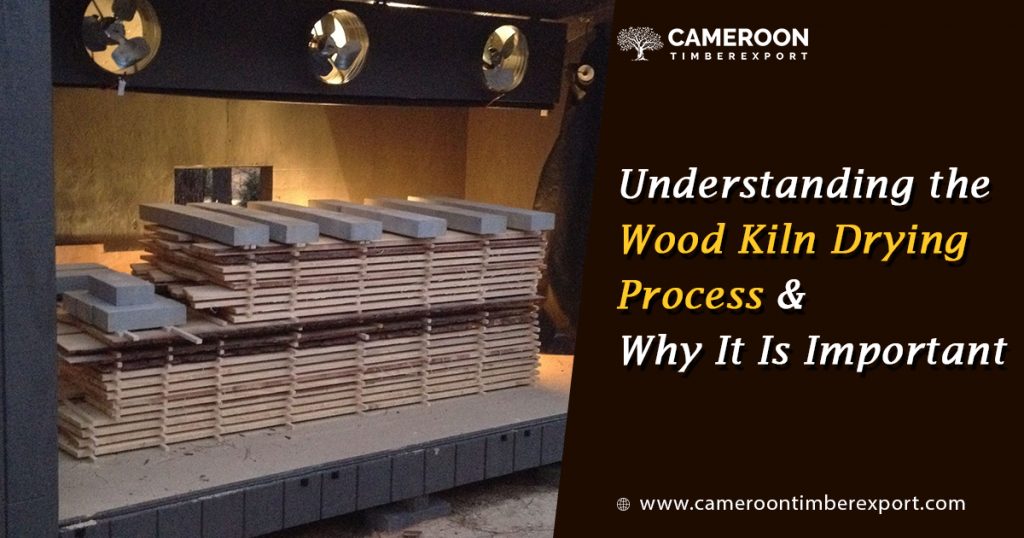Wood Kiln Drying Process involves the use of a kiln – a type of oven – to manually reduce the moisture content of wood in order to improve its workability and efficiency. Heat treatment, air drying, etc. are some other popular timber drying methods.
Here at CameroonTimberExportSarl, we use kiln drying as a standard approach to dry woods with high moisture content. Other than that, we also use the air-drying method of drying timber. Besides using kiln drying for our own in-house wood production and processing, we also provide wood drying services to other wood dealers and manufacturers in the region. Contact us or visit our website for details.
What is Wood Kiln Drying?
Kiln drying is a wood drying method used by wood production and processing mills primarily to reduce moisture content in freshly felled green lumber to make them workable and improve the quality. It involves the use of an oven-like machine called a kiln to manually extract excess moisture out of wood.
Wood that has been treated through kiln drying possess is called kiln-dried wood. Kilns are designed such that a custom atmosphere with specific temperature, humidity, and steam levels can be created for wood treatment. It’s a reportedly faster and more efficient method than air drying.
A typical kiln is made of the following four components:
- Kiln chamber – usually made of bricks, concrete or aluminium.
- A powerful source of heat
- Humidifiers to create proper humidity conditions
- Fans to provide air circulation
Why is Kiln Drying Used?
Drying fresh wood is important for many reasons. The high moisture levels in wood can lead to a range of problems, including poor workability, warping & twisting and poor overall efficiency. High moisture levels in wood do not just cause problems during production and processing but can cost significantly in damages when in use.
Kiln drying helps bring moisture levels down to a workable range so that the above-mentioned problems are reduced to a great extent.
Drying is a crucial part of the timber manufacturing/production process, which helps ensure the end products are of optimal quality and do not have excess moisture that can cause troubles later on. Wet wood is not good for many things. It cannot be used as it is for anything from firewood to construction and other projects. Moreover, the use of green lumber can cause significant damage to the entire project over time.
Without kiln drying, the fresh wood will start drying naturally over time, thus losing its moisture content and causing twists, warps or shrinks, which will not be an ideal thing for any project.
Kiln drying is considered even better than the natural wood drying process. Here’s why.
Once the tree is felled, it starts losing its moisture supply and would start drying at a rapid pace. However, that rapid drying and moisture loss can cause significant damage to the wood’s quality. Kiln drying, on the other hand, would systematically extract the moisture out of wood without causing damage to the wood itself.
Kiln drying has many benefits over other wood drying methods. Kiln-dried wood is lightweight, doesn’t warp or develop cracks over time, is highly durable and has the lowest moisture levels. The dying process not only removes moisture quickly but also kills many insects, eggs and bugs in the wood, increasing its life and value.
The Wood Kiln Drying Process
The kiln drying process involves the use of a kiln to dry the wood using heated air. The method involves the following steps:
1. Sorting of logs: After the trees are felled and logs are brought to the mill, they are first debarked and then sorted into groups based on species, size or purpose.
2. Sawing: Big logs are sawn into smaller, rough boards of different dimensions and sizes for different end-use.
3. Kiln drying: After sorting and sawing, logs or timber are fed to the kiln machine, where they are treated with circulating heated air for a specific period to rapidly remove any excess moisture content from the wood. The treatment time, kiln temperature, air pressure, etc. are preset based on the target moisture content levels. To optimize the drying process, wood is fed in the kiln in batches sorted by wood species and dimensions.
Sometimes, the drying process needs to be repeated multiple times, depending on timber species, size and moisture content, in different temperature/airflow/humidity settings to achieve the right Equilibrium Moisture Content (EMC) to reach the desired moisture content levels.
4. Planing: Immediately after kiln drying, the timber is sent through the planer for planing according to the required final dimensions and size. Then, it is packaged and shipped out.
However, one should know that kiln drying, or any other method of wood drying for that matter, will not make the wood 100% free of or resistant to moisture. It is the nature of wood to attract and react with moisture. Unless the timber is fully sealed, it will keep interacting with and absorbing moisture in its environment.
Contact us (CameroonTimberExportSarl) for kiln wood drying services or to purchase the best quality kiln-dried timber at the guaranteed lowest price.

